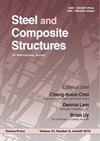Predicting seismic performance of locally corrodedsteel box-section piers
IF 3.9
3区 工程技术
Q1 CONSTRUCTION & BUILDING TECHNOLOGY
引用次数: 2
Abstract
This paper aims to propose a simplified method for predicting ultimate strength and ductility behavior of locally corroded steel box-section bridge piers. Firstly, the accuracy of the proposed 3-D elastoplastic finite element model for the steel piers subjected to a constant vertical load and cyclic lateral loading is verified by comparing the analytical results with test results. Then, a series of parametric study is carried out to investigate the effect of corrosion height ratio and corrosion thickness ratio of steel plates on the ultimate strength and ductility behavior of these piers. Finally, by establishing 2-D beam-column element models and comparing the calculation results with those of the 3-D models, correction coefficients for the ductility ratio and ultimate strength of 2-D beam-column element model under local corrosion are proposed. The research results indicate that there exists a most unfavorable corrosion height which makes the ductility ratio of steel piers the smallest. The ultimate strength of the steel piers will not have a distinct degradation when the corrosion height becomes larger than 0.5Ld. The correction coefficient formula for ductility ratio with respect to different aspect ratio of steel piers, and the linear relationship between correction strength coefficient and the corrosion thickness ratio are proposed. Correction coefficients for 2-D beam-column element model under the most unfavorable corrosion height are proven to have a rational accuracy, which provides a fast and simplified method to evaluate the ultimate strength and ductility behavior of such steel piers under local corrosion.局部腐蚀钢箱式截面桥墩抗震性能预测
本文旨在提出一种简化的局部腐蚀箱式桥墩极限强度和延性预测方法。首先,通过将分析结果与试验结果进行对比,验证了所建立的恒定竖向荷载和循环横向荷载作用下钢桥墩三维弹塑性有限元模型的准确性。然后,进行了一系列参数化研究,探讨了钢板腐蚀高度比和腐蚀厚度比对桥墩极限强度和延性性能的影响。最后,通过建立二维梁柱单元模型,并与三维模型的计算结果进行比较,提出了局部腐蚀条件下二维梁柱单元模型延性比和极限强度的修正系数。研究结果表明,存在一个最不利腐蚀高度,使钢桥墩延性比最小。当腐蚀高度大于0.5Ld时,钢墩的极限强度不会有明显的下降。提出了不同宽高比下钢墩延性比的修正系数公式,以及修正强度系数与腐蚀厚度比的线性关系。验证了最不利腐蚀高度下二维梁柱单元模型的修正系数具有合理的精度,为评估此类钢桥墩在局部腐蚀下的极限强度和延性性能提供了一种快速、简化的方法。
本文章由计算机程序翻译,如有差异,请以英文原文为准。
求助全文
约1分钟内获得全文
求助全文
来源期刊

Steel and Composite Structures
工程技术-材料科学:复合
CiteScore
8.50
自引率
19.60%
发文量
0
审稿时长
7.5 months
期刊介绍:
Steel & Composite Structures, An International Journal, provides and excellent publication channel which reports the up-to-date research developments in the steel structures and steel-concrete composite structures, and FRP plated structures from the international steel community. The research results reported in this journal address all the aspects of theoretical and experimental research, including Buckling/Stability, Fatigue/Fracture, Fire Performance, Connections, Frames/Bridges, Plates/Shells, Composite Structural Components, Hybrid Structures, Fabrication/Maintenance, Design Codes, Dynamics/Vibrations, Nonferrous Metal Structures, Non-metalic plates, Analytical Methods.
The Journal specially wishes to bridge the gap between the theoretical developments and practical applications for the benefits of both academic researchers and practicing engineers. In this light, contributions from the practicing engineers are especially welcome.
 求助内容:
求助内容: 应助结果提醒方式:
应助结果提醒方式:


